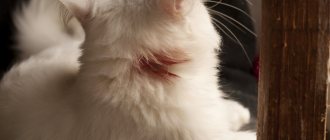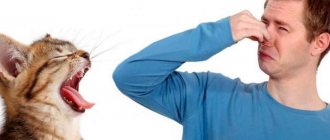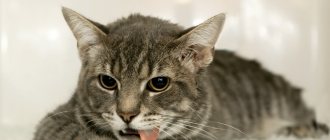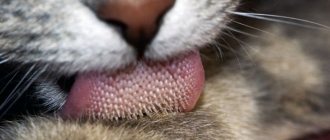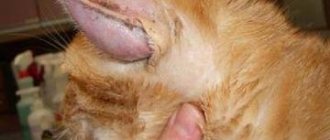Inflammation processes in the oral cavity in cats negatively affect the entire functioning of the body. The process of chewing and further digestion of food deteriorates significantly, the body's defenses are weakened, and the load on the heart muscle increases.
A responsible, attentive cat owner should be aware of the number of teeth in the pet's mouth, know how to properly care for the pet's oral cavity, and also know when to seek advice from a veterinarian.
The cat's dental system is represented by the following types of teeth: 12 incisors, 4 canines and 14 premolars. The period of replacement of milk teeth with permanent teeth ends on average by the age of eight months. It is important to note that if, when the cat reaches 12 months of age, it has not had a complete replacement of its teeth, the animal will suffer. Congenital anomaly of dental development - oligodontia, has a genetic predisposition, transmitted through generations. Such animals are discarded during breed selection and breeding.
Causes of dental disease in cats
Dental diseases in veterinary medicine have their own classification and vary in severity. There are a number of factors that negatively affect the normal physiological development of teeth in a cat. The main ones are:
- incorrect position of a row of teeth;
- dietary disorders;
- infectious diseases;
- lack of timely veterinary care for injuries and other pathologies developing in the cat’s oral cavity;
- changes in the qualitative composition of saliva and the ratio of beneficial and pathogenic microflora in the animal’s mouth (as a result, there is a risk of developing dangerous diseases);
- factor of genetic heredity (a number of cat breeds have been identified that have a predisposition to dental diseases).
Taking into account all these main factors, it is recommended to carefully carry out hygienic procedures for the cat’s oral cavity and monitor the diet so that non-soft food predominates in it. Cats with a genetic predisposition need to undergo preventive examinations by veterinarians once every six months.
Find out also about stomatitis in cats >>>
Causes of ulcerative and gangrenous stomatitis
Primary stomatitis is the simplest form of the disease. It usually occurs as a result of everyday “troubles”: food that is too cold or hot, hard pieces of food that have scratched delicate skin, chemical burns and even your own microflora (which are out of balance and corrode existing wounds).
There are known cases of stomatitis occurring as a reaction to cat shampoo - when bathing it was not washed off completely, and the cat, while licking itself, was poisoned and burned the mucous tissue. If primary stomatitis is not cured, it goes into a more acute phase.
Secondary stomatitis occurs against the background or as a consequence of other, more serious diseases. These are: severe forms of infectious diseases, stomach diseases, diabetes mellitus, vitamin deficiency, leukemia, etc.
Symptoms of toothache in cats
The cause of dental disease in cats is a large number of external environmental factors and internal pathologies. Any attentive owner can notice the appearance of characteristic signs of problems in a pet’s teeth or gums. To do this, it is not necessary to look into the animal’s mouth. The main symptoms of the development of diseases in the oral cavity are:
- pronounced rubbing of the muzzle against furniture and things, while the animal does not show pleasure;
- the appearance of a repulsive odor from the mouth;
- gum hyperemia;
- discoloration of tooth enamel;
- display of aggression when the owner tries to look into the mouth;
- refusal to eat due to pain;
- increased secretion of salivary fluid.
More serious problems
Thus, a cat's tongue can be a real "barometer" of health. A change in color is an indicator that your cat may be sick. You can remember a simple truth: “A pink tongue is a healthy pet.” This rule is immutable; exceptions are very rare.
Why is that? The fact is that the tongue, as a muscular organ, is literally penetrated by many blood vessels, visible through the thin epithelial layer. If it is pink, everything is in order - the blood supply is normal, the red blood cells contain the required amount of hemoglobin. In many cases, a white tongue is a sign of poor oral hygiene , but below we will describe much more serious pathologies in which this organ also changes its color.
The most common dental diseases in cats
Pathological conditions of the cat's oral cavity are manifested by inflammatory processes in the gums, and also affect the tooth itself. The causes may be tooth decay, for example due to caries, as well as trauma to the muzzle and jaws. The most commonly diagnosed diseases of the teeth and gums are:
- Tartar . Tartar is a layer with a porous structure. Pathology occurs when there are disturbances in feeding and untimely cleaning of plaque. As a rule, the stone forms in the base area, affecting the root and gum structures. The started process is characterized by complete coverage of the tooth body with a dense layer. resulting from untimely removal of dental plaque. Characteristic signs of the disease are a repulsive odor from the mouth, bleeding and itching in the gum area. The animal tries to make less effort when chewing solid particles of food due to the feeling of discomfort.
- Plaque. A grayish-yellow film formed under the influence of a large number of bacterial microorganisms in the mouth, food residues and salivary fluid. At the first stages, it is not noticeable to the owner and is determined exclusively by a veterinarian using special diagnostic methods. With the development of the pathological process, the film thickens, plaque covers the entire area of the tooth surface and, in the absence of hygienic procedures, turns into tartar. The formation of plaque on a cat’s teeth is determined by both genetic predisposition and an incorrect approach to feeding.
- Caries . The process of decay, as a result of which parts of the tooth, and especially the enamel, are destroyed, forming a through cavity. There are many reasons for the appearance of pathology, but the main ones are a lack of mineral nutrients due to an unbalanced diet or disturbances in metabolic processes in the body. Various mechanical injuries with the formation of a wound surface and infection lead to the penetration of pathogenic bacteria and the development of putrefactive processes in the core of the tooth.
- Odontogenic osteomyelitis . An inflammatory disease that damages the tooth, the soft tissue around it, the alveoli and even the bone marrow. The main cause of dental osteomyelitis in cats is advanced pulpitis, a complication of purulent processes (caries or periodontitis). Odontogenic osteomyelitis is characterized by hyperemia of the gums, pain when chewing food, edema and swelling of the muzzle. Often neglected odontogenic osteomyelitis is accompanied by the development of an abscess, with the further formation of fistulas through which purulent exudate can be released, and regional lymph nodes enlarge.
- Periodontitis . A common disease often diagnosed in the clinical practice of veterinarians. With the development of periodontitis, the upper part of the tooth root is affected. It is diagnosed in cats after two years of age and often becomes chronic. The development of periodontitis occurs when plaque, caries, removal of molars, blows to the crown of the tooth, foreign objects stuck in the gums and not removed in a timely manner are not removed.
- Gingivitis . An inflammatory process of a chronic nature that develops on the mucous membrane of the gums. The primary manifestations of the disease appear as a yellowish coating on the hard part of the tooth. This happens when food particles get stuck between the teeth. The tissue structures begin to become inflamed, hyperemic, bleeding and ulcerative lesions appear on the gums.
- Tooth resorption . Pathology leading to gradual tooth loss and degenerative processes in the tissue structures around them. In veterinary sources, resorption is called odontoblastic resorptive lesion, developing from the gum area, destroying tooth tissue and replacing it with bone tissue. As a rule, premolars are affected, and then other teeth may be damaged. Resorption is not a contagious pathology, but when a tooth is lost, an infection of bacterial or fungal etiology can occur, which leads to purulent tissue lesions.
Acne
In addition to the notorious blackheads, skin disease is accompanied by other symptoms:
- swelling;
- baldness;
- the skin turns red;
- small pimples appear (then there are more of them, they increase in size).
- scabies;
- demodicosis;
- allergy;
- dermatophytosis;
- eosinophilic granuloma.
If you see black dots in your cat's fur, you have plugs in the skin clogged with sebum. In this sense, animals are just like us.
If your cat has black spots near the mouth rather than inside it and they look more like dots, it may be acne. They love to “settle” on the chin, where the sebaceous glands are most active. However, they can appear in other places. The most common causes of acne are:
- Unbalanced nutrition, when the diet lacks the vitamins and minerals the cat needs. This often happens if the animal is fed from a common table.
- The sloppiness of a cat that walks around with food residue on its chin.
- Poor environmental conditions.
- Severe stress experienced by the animal.
- Dirty dishes.
- An allergic reaction to a detergent or other irritant.
- Hereditary factor.
All other causes, except the last one, can be eliminated, and the black spots around the mouth will disappear. If it’s a matter of genetics, you will have to come to terms with and console yourself with the thought that the spots do not cause any harm to the cat’s health.
Treatment of dental disease in cats
As a result of what has become the leading cause of dental disease in cats, the veterinarian selects individual treatment suitable exclusively for a particular animal.
If the cause of a cat’s dental problems is tartar, therapy is based on its complete removal. The optimal method of cleaning damaged tissue is selected, based on the severity and neglect of the degenerative process.
In the first stages of tartar formation, it is possible to eliminate it with the help of special gels or ointments. Advanced cases of plaque and tartar require anesthesia and removal of growths using ultrasonic equipment or a chisel.
Treatment for spotty and superficial caries involves treating the affected tooth with a special solution of sodium fluoride or silver nitrate. It is quite problematic to give a pet a full-fledged filling, so in the vast majority of cases of advanced caries, they are treated by removing the diseased tooth.
The initial stages of osteomyelitis can be treated with broad-spectrum antibiotics, sulfonamide medications and immunomodulatory drugs. More advanced cases of the development of dental osteomyelitis include surgical intervention under local or general anesthesia, opening of the resulting fistula, removal of purulent contents from the cavity and treatment with special antibacterial solutions.
Periodontitis can be treated by spraying the cat's mouth with disinfectant solutions. In the affected area, the tooth is treated with iodine-glycerin or a 5% alum solution. Treatment for gingivitis depends directly on the stage of neglect of the pathological process. Sick animals must undergo daily cleaning and treat the affected gums with medicinal ointments. Advanced cases require antimicrobial and hormonal therapy.
What to do if your cat has stomatitis?
If you notice at least one of the symptoms listed above, contact your veterinarian. He will examine your pet and prescribe the necessary tests and treatment for ulcerative stomatitis. Before that, you need to change the animal’s diet - he cannot chew, and it hurts to swallow. Therefore, remove everything hard, spicy, hot and cold from the menu, let everything be warm and creamy.
Afterwards, you need to disinfect: take a 3% chlorhexidine solution or a 1% soda solution and rinse your mouth with it. This procedure should be done several times a day, after each meal. If you have Lugol in your medicine cabinet, then you can start smearing wounds by mixing it with glycerin. If necessary (and it will most likely appear), give your cat antiviral agents and a complex of vitamins to maintain his immunity.
